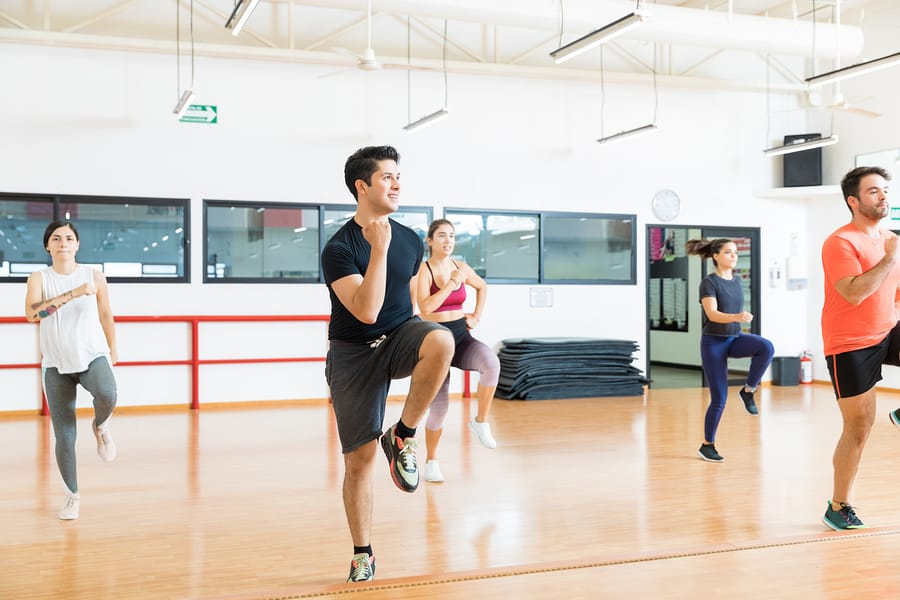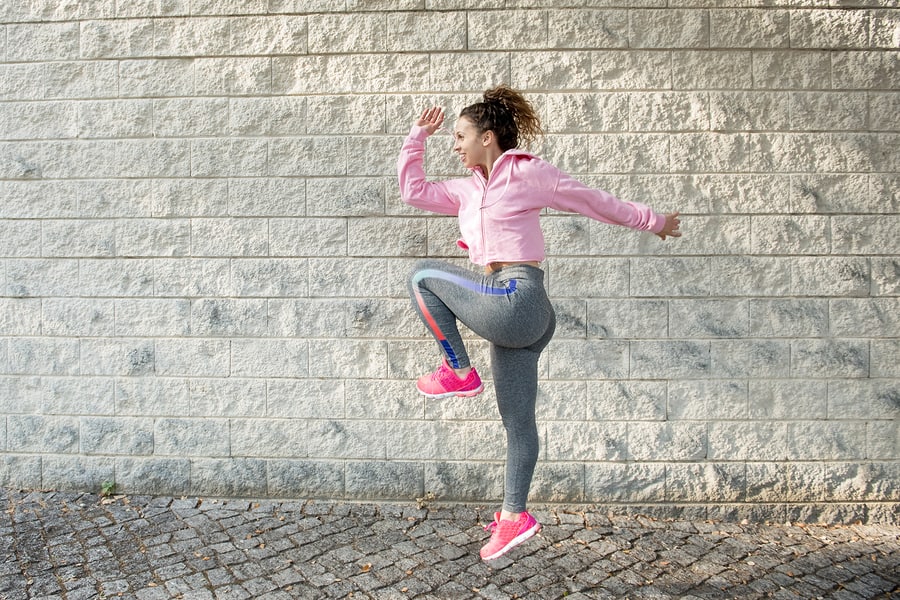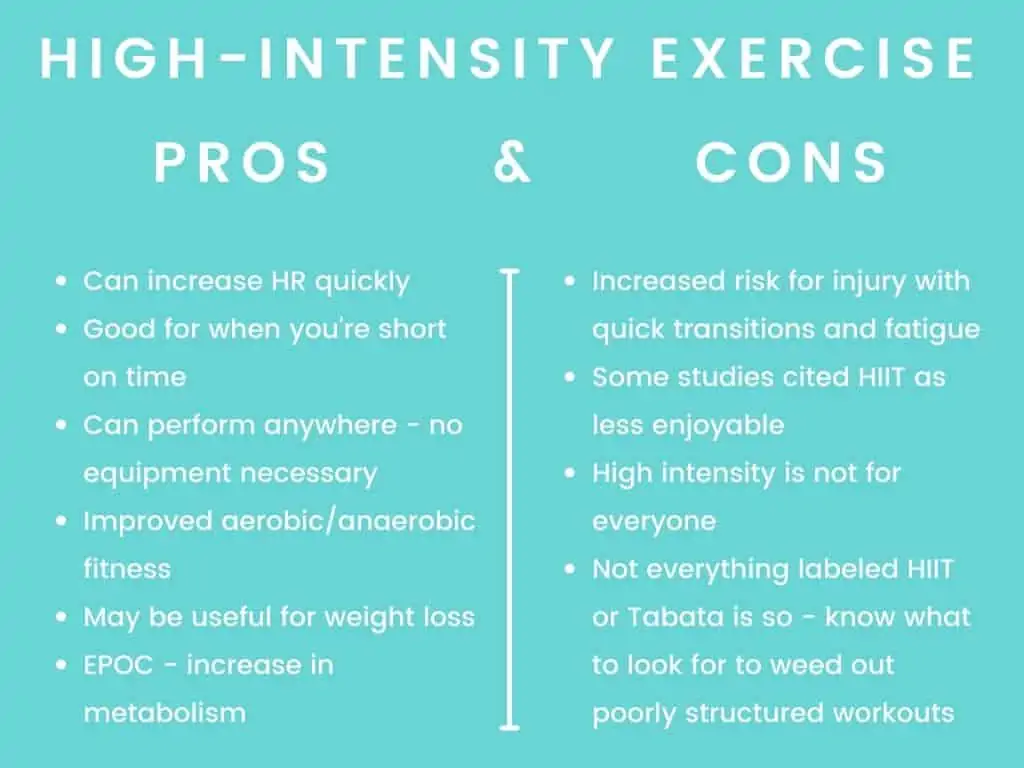This post may contain affiliate links. If you click through a link and make a purchase, I may receive a commission at no additional cost to you. As an Amazon Associate, I earn from qualifying purchases. Read the full disclosure here.
Tabata, HIIT (high-intensity interval training), and interval training are all terms thrown around the fitness scene. These terms are often used interchangeably and sometimes incorrectly, even by fitness professionals.
Let’s take a look at the science, the pros, the cons, and the bottom line to help you choose which workout routine might be best for you.
- Tabata vs HIIT vs interval training
- What’s the science behind HIIT workouts?
- The Tabata Workout
- What are HIIT workouts?
- HIIT vs interval training
- How to measure exercise intensity
- What should you eat before a HIIT workout?
- Pros & cons of Tabata and HIIT style workouts
- What type of shoes are best for Tabata & HIIT workouts
- Key takeaways
Disclaimer: This content is for educational purposes and is not medical advice. Read the full disclaimer.
Tabata vs HIIT vs interval training
Tabata and HIIT are forms of interval training. But interval training alone does not make a workout Tabata or HIIT.
Stay with me, let’s break this down a little further.
Tabata is a form of high-intensity interval training (HIIT). The HIIT concept isn’t new to athletes but is gaining popularity in the mainstream fitness world, and you’ve likely heard of it in passing.
HIIT style workouts claim to burn more fat and calories in a shorter period of time, increase your metabolism, boost heart health and endurance, and other enticing headlines that get you to click.
Sounds too good to be true, right? Well, yes and no.
It depends on how you implement these programs, what’s right, and what’s right for you.
What’s the science behind HIIT workouts?
Does high intensity exercise really deliver on its bold health claims?
To fully understand the HIIT phenomenon, let’s dig into the science of aerobic and anaerobic exercise and how it relates to cardiovascular fitness.
Aerobic energy system
This word might give you visions of colorful leotards, but in this case, aerobic exercise means with oxygen. The demand for oxygen hasn’t exceeded the amount of oxygen the body can take in.
The aerobic energy system uses fuel sources such as carbohydrates, fats, and protein to break down into energy.
The average low to moderate cardio workout, as well as everyday life activities, use this energy pathway. The aerobic system produces a lot of energy, but it at a slower pace.
So what happens when you need a lot of energy, and fast?! Enter, the anaerobic system.
Anaerobic energy system
Your body switches between the aerobic and anaerobic systems behind the scenes during workouts based on intensity and energy demands.
The anaerobic system provides short bursts of intense energy.
The demand for energy has exceeded the amount of oxygen the body can take in, so the body turns to the anaerobic system to quickly convert carbohydrates into energy.
The anaerobic system can make energy quickly, but it can’t make that much at one time, therefore it’s not sustainable for longer periods (think sprinting). HIIT relies on getting to this training zone to reap the benefits (and also why HIIT workouts are shorter in duration).
Excess post-exercise consumption (EPOC)
Also known as the after-burn effect, this is a significant selling point of HIIT training.
The more intense the workout, the more oxygen your body requires to recover. In theory, you will continue to burn calories for some period of time following exercise.
Do I think EPOC exists? Yes, because I’ve read the science.
But I also think it’s somewhat oversold. (I’m just saying, the math will be different from person to person based on numerous factors.)
Let’s be honest; the fitness industry loves to take science out of context, not give you the full story, and sell you literally anything to make money. I love this article from Breaking Muscle, which digs deeper into the science of EPOC – a must-read.
The research also shows that EPOC varies considerably based on a multitude of individual factors in addition to the intensity one puts into the workout.
The takeaway, if you’re counting calories, anything is a welcome bonus, but I wouldn’t bank on someone else’s numbers or the promise of calories later that are difficult to track, because we’re all different.
How many calories do you burn in a Tabata class?
Calorie burn varies significantly between people and is dependent upon many factors including effort you put into the workout, length of the workout, height, weight, and individual genetics.
A study by ACE Fitness concluded that it’s possible to burn between 240 and 360 calories in a 20-minute Tabata session.
This is assuming you put in full effort for the entire workout and the workout was structured properly with high-cardio and compound strength movements. (20:10 intervals of crunches don’t count as Tabata just because they’re done in that time interval.)
The best way to know your calorie burn? Use a good quality fitness watch that accurately monitors heart rate.
Related read: How Do Fitness Trackers Work & Which Ones Are The Best

The Tabata Workout
In 1996, Dr. Izumi Tabata tested a HIIT protocol on college-aged physically active males after witnessing improvements in performance with elite Japanese speed skaters using high-intensity interval training.
The Tabata protocol consists of:
- 20 seconds of high-intensity work
- 10 seconds of rest
- Repeat for 8 rounds (a total of 4 minutes)
Long story short, there were two groups and a stationary bike. One group did moderate-intensity cardio for 60 minutes at 70% VO2max (a fancy measure of oxygen uptake during exercise as a means to measure the intensity and aerobic capacity) five days per week.
The high-intensity group did the 4 minute Tabata workout with the work phase at 170% VO2max five days per week. One day per week, the high-intensity group did 30 min of moderate-intensity prior to the 4 minute workout. (170% VO2max is crazy intense, for those of you tracking that.)
After 6 weeks, the study found that the group that did the 4-minute high-intensity workout had improved aerobic and anaerobic capacity versus the group that did moderate-intensity cardio for 60 minutes.
Here’s where the wheels fall off the bus.
Don’t interpret that as wow so I only have to exercise for 4 minutes and get the same results?! Or the opposite, if 4 minutes is good 60 must be better!
And if it works for cycling, it must work if we substitute other exercises in there too. Not so fast.
Then the idea gets kicked around the fitness world; people get cute and change the exercises but still try and say you will get the same results because it’s Tabata!
Yeah, but you changed it, so, like, it’s not.
“Tabata abs” lying on your back for 4 min is not the Tabata method. Sorry.
A deeper dive into the science of Tabata
The original research was reliant on the intensity of the work phase to produce these results.
170% of VO2max is exceptionally intense, higher than many people can safely physically attain (or want to). It was also tested with cardio on a stationary bike in a lab with lots of fancy equipment using young and active males as test subjects.
My point is, the mixed bag of YouTube results for “Tabata workout” where half of the workout is strength exercises or laying down doing crunches, will not deliver similar results. No matter how many bridges you do, your heart rate isn’t getting near that zone.
Exercises such as high knees, squat jumps, sprint intervals, and skaters will get you closer to the goal of high-intensity. Keep this in mind when searching for videos if you want that high-intensity experience.
Now before anyone gets excited, there’s isn’t anything wrong with doing 20:10 intervals of strengthening exercises or even something like crunches. After eight rounds, you’ll probably get some intense muscle fatigue. But what it won’t do is deliver the same results because those exercises just don’t increase your heart rate to maximum intensity.
It’s more like Tabata-inspired.
Make sure you know the difference between what you’re getting and what you think you’re getting from a workout.
What are HIIT workouts?
HIIT alternates between intense (80-95% of your max heart rate) efforts of work and rest.
The intervals are not specifically 20:10. HIIT protocols vary, but it may be 30:60, 30:30, or some other ratio.
There also isn’t a set time, however, usually, 30 minutes is the max. The longer the training, the less intense the intervals. It’s physically impossible to work those energy systems for long periods of time if you’re getting into that high-intensity anaerobic zone.
Like Tabata, HIIT exercises need to be something that will raise your heart rate to maximum intensity, otherwise, you’re just doing intervals.
Is Tabata more effective than HIIT?
Both workouts are highly effective at burning fat when applied properly.
Tabata intervals are shorter but aimed at a higher intensity. HIIT intervals are still intense but performed for a longer period of time.
There isn’t any specific evidence that Tabata is more effective than HIIT at this time.
Injury Prevention Tip: The rest phases are just as important so your body can recover. If there aren’t proper intervals, you won’t be able to sustain the energy system (anaerobic) required for HIIT benefits for long, and it will become steady-state cardio and increase your chance of injury. The same reason why doing HIIT for longer than 30 min isn’t necessarily better.
If you’re newer to HIIT, start with more extended rest periods and adjust the ratios as your fitness level improves.
Don’t know where to start? Check out the HIIT workouts on Aaptiv, a guided audio workout app that you can take anywhere!
HIIT vs interval training
Both Tabata and HIIT are based on maximal effort during the work cycle to get into that anaerobic zone.
Interval training is simply exercising at different levels of intensity, but not specifically high-intensity. Work and rest ratios may also be longer.
Moderate intensity does not carry the same EPOC benefits that high intensity does. This isn’t necessarily a con, but important to know the difference between these workouts to align with your expectations.
An interval workout might be suitable for those looking to work at a more moderate level.
All three of these workouts differ from steady state cardio by adding interval components in some form.
Is interval training the same as circuit training?
Circuit training is not quite the same as interval training. During circuit training, you’re moving between 5-10 exercises that target different muscle groups with little rest in between.
Because you’re targeting different muscle groups, you don’t necessarily need to rest and can keep your heart rate higher.
How to measure exercise intensity
There are three easy ways to measure your intensity to make sure you’re getting the most benefit from HIIT style workouts: heart rate monitoring, perceived exertion, and the talk test.
Understanding your maximum heart rate zone can help you get the most out of your workouts, especially when it comes to high intensity.
Heart rate monitoring
Read this article for more information on how to monitor your heart rate during exercise by taking your pulse.
You can also use a heart rate monitor. Keep in mind many factors can alter the reading on your heart rate. The most accurate readings come from using a chest strap to monitor.
If you’re just getting started with fitness trackers, check out the Fitbit Charge & Fitbit Versa.
Read The Ultimate Guide to Fitness Trackers to learn the science behind how fitness trackers work and which ones are the best!
Perceived exertion
Perceived exertion is how hard you think you’re working.
This is usually measured on a 1-10 scale, 1 being extremely light and 10 being hardest work. Moderate intensity falls around 4-6. High-intensity is considered 7-9+.
The talk test
The other super-easy way is by using the talk test.
At low intensities, it should be very easy to talk. At moderate intensities, it should be more difficult to carry a conversation as your heart rate rises. At high intensities, it will be difficult to manage more than a few words.
What should you eat before a HIIT workout?
Proper nutrition and fitness work side by side to give you the best results. However, working out at maximum intensity and big heavy meals don’t really go together.
This article from Total Shape suggests eight energy-filled meals to keep you fueled during your workout, but won’t weigh you down and make you feel sluggish.

Pros & cons of Tabata and HIIT style workouts
Pros
- Ability to increase your heart rate quickly
- Useful when you’re short on time
- Option to vary fitness routines
- Perform anywhere
- No equipment necessary
- May be useful for weight loss
- Improved aerobic and anaerobic fitness vs. only performing steady-state cardio.
- Can be an effective training method for runners or other athletes as part of a cross-training plan.
- EPOC, increase in metabolism
Cons
- Increased risk for injury: quick movements, and transitions can be challenging to maintain proper form.
- In some studies, participants cited HIIT as less enjoyable than steady-state cardio.
- Although Tabata is touted as a 4 min workout, you still need to warm up. Going from zero to all out intensity increases your risk for injury.
- You can’t get a well-rounded fitness program in 4 min.
- Not everything labeled “Tabata” is Tabata (or HIIT). Know what to look for to weed out poorly structured workouts.
- The words “high-intensity” can be deterring to some who feel their fitness is not at a high enough level or that level of intensity is not safe for them.
- Intense exercise is not for everyone, especially beginners. If high intensity is not your thing, you can still incorporate interval training at lower intensities – remember just move!

What type of shoes are best for Tabata & HIIT workouts
The right shoes can make or break a workout. Some of it may depend on whether your workout is more strength-focused or more cardio-focused.
A good all-around shoe for Tabata and HIIT workouts is a cross-training shoe.
Cross-training shoes allow for quick pivoting motions due to their smoother bottom and lateral stability.
Take a look at these highly-rated cross-training shoe options for men and women:
Check out 11 Signs You’re Not Wearing The Right Shoes For Your Feet to learn more.
Key takeaways
Cardiovascular exercise helps to improve overall fitness.
Evidence suggests interval training, including HIIT and Tabata protocols, can improve aerobic and anaerobic capacity over steady-state cardio in less time.
Interval workouts have the potential to reap benefits such as improved fat burning, improved metabolism, etc. to accelerate fat loss if they are performed at the right intensities. Always listen to your body.
There may be a place for one of these workouts in your routine based on individual needs, but not everything is great for everyone, so choose wisely to avoid injury.
There are many different types of high intensity training protocols, so you might have to dig a little deeper to determine the ones that work for you.
Understand the science behind why and how often you should use these workouts for results, not just “it’s popular right now.”
The optimal prescription for HIIT workouts is 2-3x per week in your fitness routine. Adding more may increase your risk of injury. Incorporate these workouts as part of a well-rounded fitness routine.
The best workouts are the ones you will look forward to doing, so if high-intensity doesn’t interest you, the likelihood of sticking with a program, in the long run, is reduced. Interval training at lower intensities or traditional cardio might be more your vibe.
Just keep moving!
Related Articles:
- 4 Secrets to a Well-Rounded Fitness Routine
- Aaptiv Review – A Hands-On Look at this Popular Fitness App
- 18 Low Impact Workout Options to Keep You Moving
- 17 Ideas to Make Home Workouts Less Boring
Featured image credit: Nandux / bigstockphoto.com
References
Alansare A, Alford K, Lee S, Church T, Jung HC. The Effects of High-Intensity Interval Training vs. Moderate-Intensity Continuous Training on Heart Rate Variability in Physically Inactive Adults. Int J Environ Res Public Health. 2018;15(7):1508. Published 2018 Jul 17. doi:10.3390/ijerph15071508
Emberts T, Porcari J, Dobers-Tein S, Steffen J, Foster C. Exercise intensity and energy expenditure of a Tabata workout. J Sports Sci Med. 2013;12(3):612–613. Published 2013 Sep 1.
Foster C, Farland CV, Guidotti F, et al. The Effects of High-Intensity Interval Training vs. Steady State Training on Aerobic and Anaerobic Capacity. J Sports Sci Med. 2015;14(4):747–755. Published 2015 Nov 24.
Hottenrott K, Ludyga S, Schulze S. Effects of high-intensity training and continuous endurance training on aerobic capacity and body composition in recreationally active runners. J Sports Sci Med. 2012;11(3):483–488. Published 2012 Sep 1.
Ito S. High-intensity interval training for health benefits and care of cardiac diseases – The key to an efficient exercise protocol. World J Cardiol. 2019;11(7):171–188. doi:10.4330/wjc.v11.i7.171
Olson, M. Tabata: It’s a HIIT! ACSM Health & Fitness Journal. 2014;18(5):17-24. doi: 10.1249/FIT.0000000000000065
Tabata I, Nishimura K, Kouzaki M, Hirai Y, Ogita F, Miyachi M, Yamamoto K. Effects of moderate-intensity endurance and high-intensity intermittent training on anaerobic capacity and VO2 max. Medicine & Science in Sports & Exercise. 1996;28(10):1327-1330.
Tabata, Izumi. (2019). Tabata training: one of the most energetically effective high-intensity intermittent training methods. The Journal of Physiological Sciences. 69. 10.1007/s12576-019-00676-7.
Townsend, Jeremy & Stout, Jeffrey & Morton, Aaron & Jajtner, Adam & Gonzalez, Adam & Wells, Adam & Mangine, Gerald & McCormack, William & Emerson, Nadia & IV, E.H. & Hoffman, Jay & Fragala, Maren & Cosio-Lima, Ludmila. (2013). Excess post-exercise oxygen consumption (EPOC) following multiple effort sprint and moderate aerobic exercise. Kinesiology. 45. 16-21.







